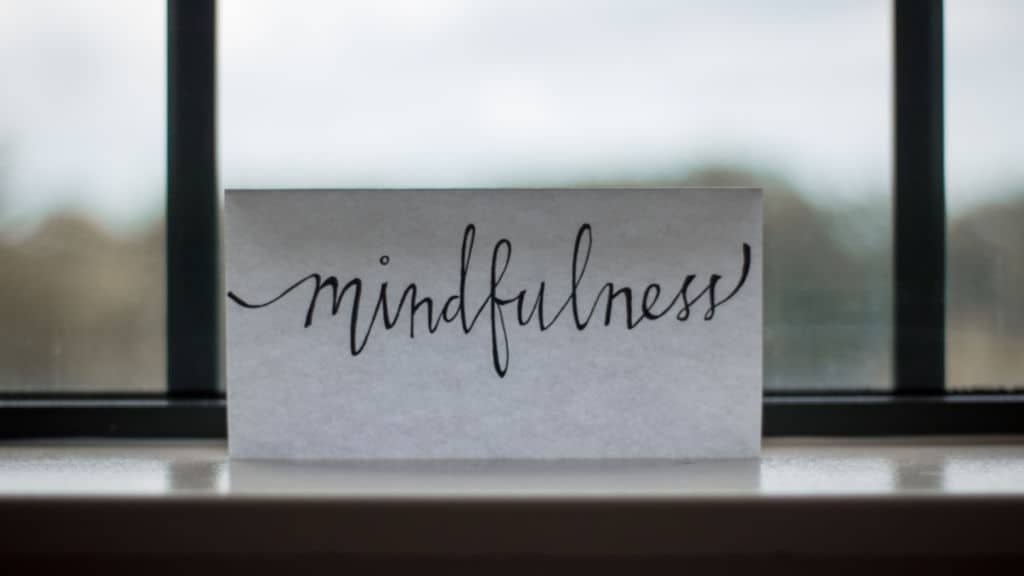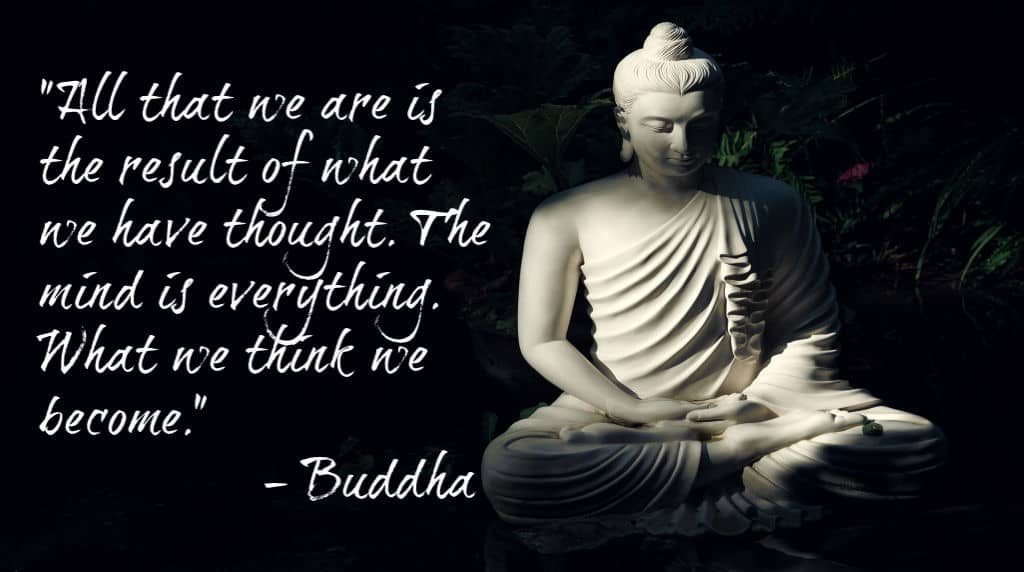(This is part one of a 3-part series discussing the history, culture, and meaning of mindfulness. In each of the three parts, we will provide some practical advice on how to implement the practice in your everyday life. We will also discuss how to practice mindfulness meditation.)
Mindfulness is all the buzz nowadays, but what exactly is it? Where did it come from? How does one practice it?
We will discuss all of these questions and more in our three-part series. In this, part one, we’ll talk about the history of the practice. So let’s get to it!
What is Mindfulness?
“Mindfulness is mirror-thought. It reflects only what is presently happening and in exactly the way it is happening. There are no biases.” ~ VH Gunaratana (source)
Mindfulness is the English translation of the Pali word sati. The word sati denotes an activity. However, describing mindfulness, or sati, using words is tricky. That’s because sati isn’t a logical practice; it doesn’t involve the use of symbols or words.
In easy terms, this is a state of constant awareness. According to Buddhists, mindfulness is the “ability to keep something in mind.” Traditional mindfulness is a trio of practices:
[1] Remembering to remain alert in the present moment.
[2] Recognition of the skillful and unskillful mind qualities as they arise.
[3] Abandonment of the qualities that hinder concentration. Cultivation of the qualities that promote concentration.
In the Satipatthana Sutta, “The Establishing of Mindfulness Discourse,” Buddha provides instructions on the first and second parts of the triune.
We’ll talk more about this in the section titled “The Early History of Mindfulness.”
In the Western World
“…a moment-to-moment awareness of one’s experience without judgment. In this sense, mindfulness is a state and not a trait. While it might be promoted by certain practices or activities, such as meditation, it is not equivalent to or synonymous with them.” ~ The American Psychological Association (source)
There are many ways in which “old” and “new” mindfulness are similar. There are some ways that they are not. Most notably, as traditional mindfulness attempts to answer questions ungraspable by the mind as-is, the latter practice necessitates the addition of mental concepts.
While traditional practice is focused more on the alleviation of suffering, “new” mindfulness is built around making modern life more tolerable. Most definitions around the practice are very similar. Dr. Jon Kabat-Zinn, considered the father of mindfulness in the West, defines mindfulness as:
“The awareness that arises from paying attention, on purpose, in the present moment and non-judgmentally”
Let’s unpack Zinn’s definition.
– “The awareness…” Or, being alert to the unfolding of an event; noticeable through the act of “paying attention.”
– “on purpose…” Modern mindfulness is an act of intention.
– “in the present moment…” The ever-present “Now.”
– “non-judgmentally…” Not labeling emotions or thoughts as good, bad, or neutral.
Kabat-Zinn’s mindfulness-based stress reduction program, or MBSR, is perhaps the most popular secular form of mindfulness in the world. The 8-week, evidence-based program is designed to assist people with reducing the symptoms of anxiety, depression, pain, and stress.
So, another possible definition of mindfulness is:
“Being alert to the continuous unfolding of the present, without labels, using deliberate attention.”
So, here are three pretty good definitions of mindfulness. Take your pick!
What are you paying attention to? Mostly emotions, thoughts, or experiences. Some schools of thought preach some form or another of meta-awareness. Meta-awareness involves the monitoring of all three.
The Early History of Mindfulness
“Do not dwell in the past, do not dream of the future, concentrate the mind on the present moment.”~ The Buddha
While mindfulness has taken roots in the West, the theory and practice of the practice go back nearly 2,500 years. It was then that Siddhartha Gautama, who would later become the Buddha, gave his discourses on the early practice of mindfulness.
Contemporary translations of the Buddha’s discourses in the Satipatthana Sutta note the following qualities of mindfulness:
– Acceptance: the ability to accept the state of one’s mind, whether “good” or “bad.”
– Detachment: The observance of the basic nature of physical, mental, and emotional phenomena without attachment.
– Impartiality: Not becoming infatuated with “good” states of mind. Not sidestepping the “bad” states of mind.
– Non-judgmental observation: looking at the contents of the mind without judgment.
– Non-intellectualization: mindfulness does not involve the intellect. Indeed, there is no intellectual awareness. Instead, mindfulness necessitates “bare awareness.”
– Noting: the reflection of three qualities – impermanence, selflessness, and unsatisfactoriness.
– Present-moment awareness: fine attunement to the continuously unfolding Now.
In the Satipatthana Sutta (Location: Majjhima Nikaya [MN] 10) the Buddha notes the importance of mindfulness:
“This is the direct path for the purification of beings, for the overcoming of sorrow and lamentation, for the disappearance of pain and distress, for the attainment of the right method, for the realization of unbinding – in other words, the four establishments of mindfulness…” (source)
The Four Foundations of Mindfulness
The Buddha goes on to mention what Buddhist scholars refer to as the “Four Foundations of Mindfulness”:
- 1 – Mindfulness of the Body: Mindfulness of the breath, the four postures (sitting, standing, walking, and lying down), clear comprehension, parts and elements, and death and impermanence.
- 2 – Mindfulness of Feelings: Mindfulness of sensations and emotions, and harmful and beneficial feelings.
- 3 – Mindfulness of Mind: Mindfulness of mind and consciousness and of mental states.
- 4 – Mindfulness of Mental Qualities (or dhamma): Mindfulness of hindrances, clinging and the fetters, the factors of enlightenment, and the “four truths and eight steps.”
Then there are three “fundamental activities” of the practice. These include the following:
- reminding us what we’re supposed to be doing
- seeing things as they really are
- seeing the true nature of all phenomena.
The various of mindfulness is based on the Tibetan, Vipassana, and Zen traditions. Thich Nhat Hanh, a Zen master, is often credited with bringing mindfulness Westward.
Uses for Mindfulness
“Methodologically rigorous randomized controlled trials (RCTs) have demonstrated that mindfulness interventions improve outcomes in multiple domains…”
~ Creswell, J. David, ‘Mindfulness Interventions,’ Annual Review of Psychology (source)
Besides assisting one along their spiritual path, this awareness is useful in numerous arenas. Among these arenas is healthcare, where thousands of scientific and medical studies have documented the mental- and physical health benefits.
Since the 1970s, physicians, psychiatrists, psychologists, and other health practitioners have utilized effective techniques to treat numerous afflictions. These techniques, often called mindfulness-based interventions (MBI) have also improved the wellbeing of millions of people.
According to researchers from Harvard University Medical School, there exists a horde of evidence for MBIs in the treatment of anxiety, depression, and chronic pain. There is also evidence that MBIs may helpful in the treatment of numerous physical conditions, from fibromyalgia to psoriasis.
Practicing Mindfulness
“Mindfulness is available to use in every moment, whether through meditations and body scans, or mindful moment practices like taking time to pause and breathe when the phone rings instead of rushing to answer it.”
~ Jon Kabat-Zinn
Next up, we will discuss how to practice it in everyday life. But first, a word of caution.
We’ve seen relatively recent popularity of mindfulness in the West. Thus, it seems like everyone has become a subject matter expert. Moreover, some people are trying to make a quick buck. And, others truly do see themselves as experts in the field.
The bottom line: look at the source. Glean information from only trustworthy, research-based, or Buddhist-based sources.
Moving on!
There are basically two ways to practice mindfulness: on the meditation cushion and off the meditation cushion. To be clear, this is often associated with meditation, but it doesn’t require that one meditate to realize some benefits.
Here are some basic instructions for both techniques.
Mindfulness Meditation
Step 1: Sit in a posture that invites feelings of relaxation, stillness, vigilance, and dignity. You may also lie down.
Step 2: Then, allow your attention to settle on the breath at the nose or the sensations flowing in and out of your body. Wherever you find the sensations of the breath to be most vivid, focus at that point.
Step 3: Keep your attention on the breath through the full duration of each in-breath and the full duration of each out-breath.
Step 4: Keep the mantra in mind: “Breath by breath. Moment by moment.” If you find that you are distracted, do not reprimand yourself. Gently bring your attention back to the sensations of the breath.
Step 5: Finally, repeat steps 3 and 4 for 10 minutes. Slowly increase the allotted time as you become more proficient.
Mindfulness Off the Cushion
Off-the-cushion practice is arguably more valuable than on-the-cushion. In addition, it’s a good thing, considering that almost none of us can – or will – dedicate hours to meditative practice.
Fortunately, you can implement mindfulness into pretty much any daily activity.
When waking up, bring your attention to the feelings of your body. Then arise slowly and deliberately. Here’s another one. While brushing your teeth, pay attention to the sounds of the brush, the taste of the toothpaste, and the motions of your hands. Or, even be aware when washing the dishes, paying attention to the sound of the water, the feel of the detergent, and so on.
When working on the computer, work single-mindedly. Keep your attention on one task. A famous Zen master was once asked, “What is Zen?” to which he replied, “Doing one thing at a time.”
So, do one thing at a time. Then, watch your life transform itself.
This is mindfulness.















